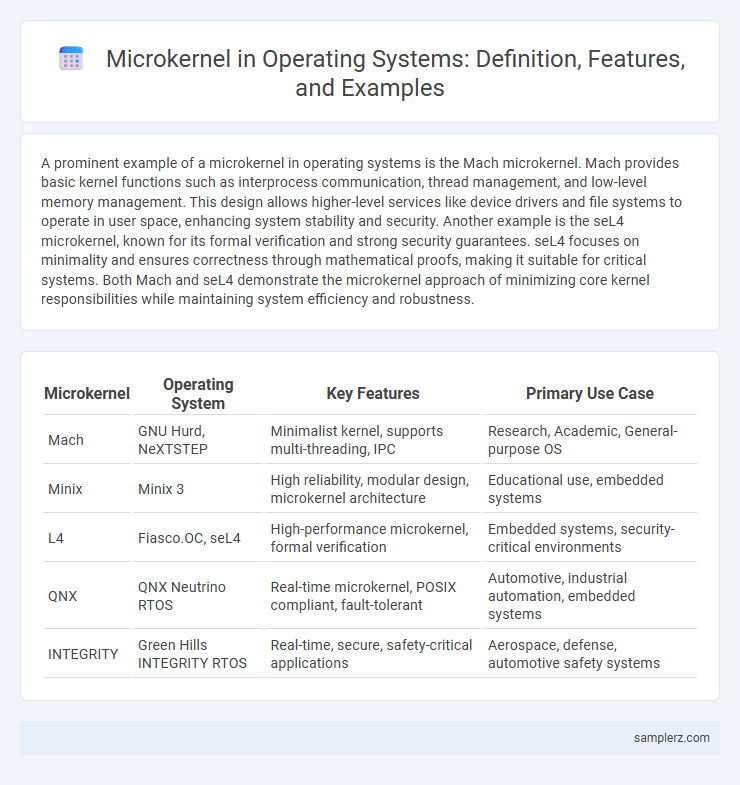A prominent example of a microkernel in operating systems is the Mach microkernel. Mach provides basic kernel functions such as interprocess communication, thread management, and low-level memory management. This design allows higher-level services like device drivers and file systems to operate in user space, enhancing system stability and security. Another example is the seL4 microkernel, known for its formal verification and strong security guarantees. seL4 focuses on minimality and ensures correctness through mathematical proofs, making it suitable for critical systems. Both Mach and seL4 demonstrate the microkernel approach of minimizing core kernel responsibilities while maintaining system efficiency and robustness.
Table of Comparison
| Microkernel | Operating System | Key Features | Primary Use Case |
|---|---|---|---|
| Mach | GNU Hurd, NeXTSTEP | Minimalist kernel, supports multi-threading, IPC | Research, Academic, General-purpose OS |
| Minix | Minix 3 | High reliability, modular design, microkernel architecture | Educational use, embedded systems |
| L4 | Fiasco.OC, seL4 | High-performance microkernel, formal verification | Embedded systems, security-critical environments |
| QNX | QNX Neutrino RTOS | Real-time microkernel, POSIX compliant, fault-tolerant | Automotive, industrial automation, embedded systems |
| INTEGRITY | Green Hills INTEGRITY RTOS | Real-time, secure, safety-critical applications | Aerospace, defense, automotive safety systems |
Introduction to Microkernel Architecture
Microkernel architecture in operating systems is characterized by a minimal core that handles fundamental tasks such as inter-process communication, basic scheduling, and memory management, while other services run in user space. An example of this architecture is the MINIX microkernel, designed to enhance system stability and security by isolating drivers and services from the core kernel. This modular approach contrasts with monolithic kernels and facilitates easier maintenance, faster debugging, and improved fault tolerance in modern operating systems.
Key Features of Microkernel-Based Operating Systems
Microkernel-based operating systems like QNX and MINIX prioritize minimalism by running only essential services such as inter-process communication and basic scheduling within the kernel, enhancing system stability and security. These microkernels enable modular design by delegating drivers, file systems, and network protocols to user space, allowing easier updates and fault isolation. Their architecture supports scalability and real-time performance, making them ideal for embedded systems and critical applications where reliability and responsiveness are paramount.
Examples of Microkernel Operating Systems
MINIX, Mach, and QNX serve as prominent examples of microkernel operating systems, designed for enhanced modularity and fault isolation. Microkernels focus on running essential services like memory management and inter-process communication in the kernel space, while moving drivers and other components to user space. These design principles enable improved system stability and security compared to monolithic kernels.
QNX: A Leading Commercial Microkernel OS
QNX is a leading commercial microkernel operating system widely used in embedded systems, known for its reliability and real-time performance. The microkernel architecture of QNX separates core functions such as process management and communication into minimal, independent services, enhancing system stability and security. Its modular design allows developers to customize and extend functionality while maintaining robust fault isolation and scalability.
Minix: Educational and Research Microkernel
Minix is a widely recognized example of a microkernel operating system designed primarily for educational and research purposes, emphasizing simplicity and modularity. Its microkernel architecture separates core functionalities like memory management, process scheduling, and inter-process communication into minimal, isolated components. This design aids in understanding OS principles and enhances system reliability by minimizing kernel-level code and facilitating easy debugging and extensions.
L4 Microkernel Family: Performance and Flexibility
The L4 microkernel family exemplifies high-performance and flexibility in operating system design by minimizing kernel size and delegating most services to user space. Its efficient inter-process communication (IPC) and fast context-switching enable real-time applications while maintaining robust security and modularity. Variants like seL4 provide formal verification guarantees, making L4 microkernels ideal for embedded systems and security-critical environments.
Integrity: Microkernel for Embedded Systems
Microkernels, such as the Integrity operating system by Green Hills Software, exemplify robustness in embedded systems through their minimalistic design that isolates essential services from user processes, enhancing security and stability. Integrity leverages a microkernel architecture to provide strong process isolation, real-time performance, and deterministic behavior critical for safety-critical applications in aerospace and automotive industries. This architecture ensures system integrity by preventing faults in one component from cascading, maintaining operational reliability in embedded environments.
Google Fuchsia: Modern Microkernel Implementation
Google Fuchsia exemplifies a modern microkernel operating system designed for scalability and security, utilizing the Zircon microkernel. Zircon provides minimal core services such as thread management, inter-process communication (IPC), and hardware abstraction, enabling modular system components to operate with enhanced reliability. This microkernel architecture allows Fuchsia to support diverse devices ranging from IoT gadgets to smartphones, demonstrating efficient resource management and robust performance.
Genode OS Framework: Advancing Microkernel Design
The Genode OS Framework exemplifies advanced microkernel design by providing a modular architecture where minimal kernel services enable robust security and flexibility. Its unique approach leverages a small, verifiable microkernel that delegates complex functionalities to user-level components, enhancing system reliability. This design facilitates efficient resource management and isolation, empowering next-generation operating systems with improved scalability and security.
Comparative Analysis of Microkernel Examples
The microkernel architecture in operating systems, exemplified by MINIX and QNX, demonstrates distinct design philosophies emphasizing minimal core functionality to enhance system stability and security. MINIX prioritizes educational use and fault isolation, while QNX targets real-time performance and embedded applications, delivering high reliability in critical systems. Comparative analysis reveals QNX's superior scalability and low-latency interprocess communication, making it ideal for automotive and industrial control, whereas MINIX offers modularity beneficial for research and academic environments.

example of microkernel in operating system Infographic
 samplerz.com
samplerz.com